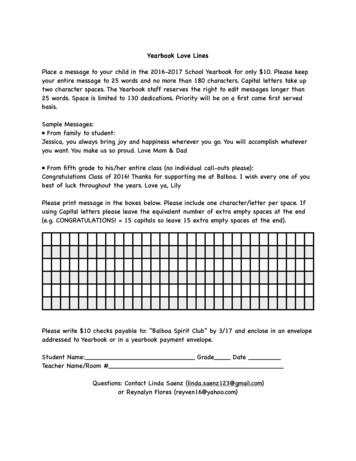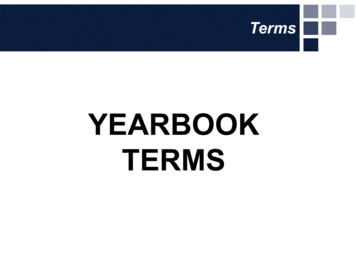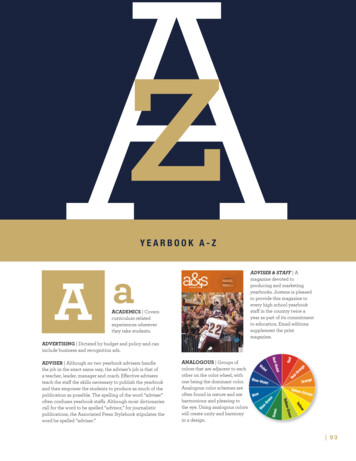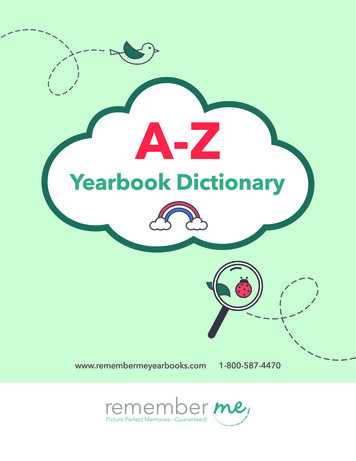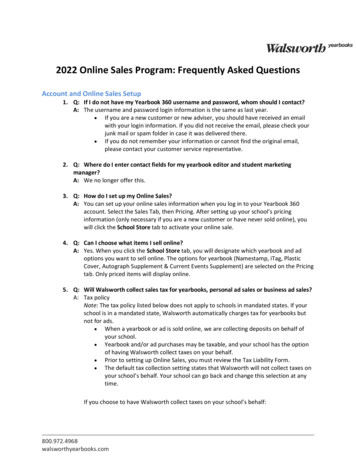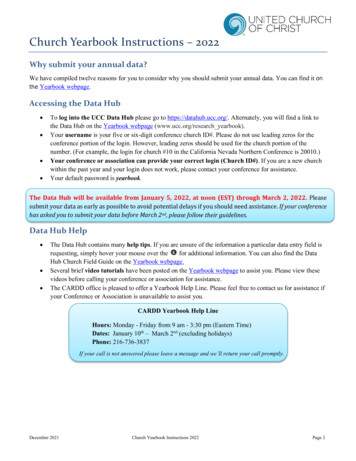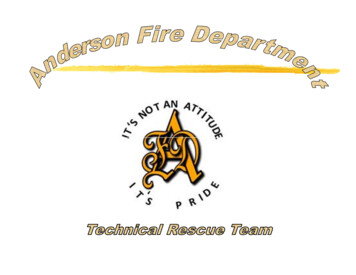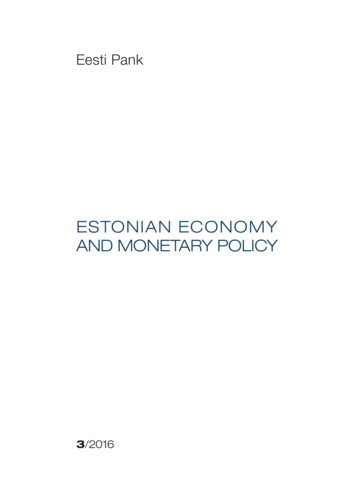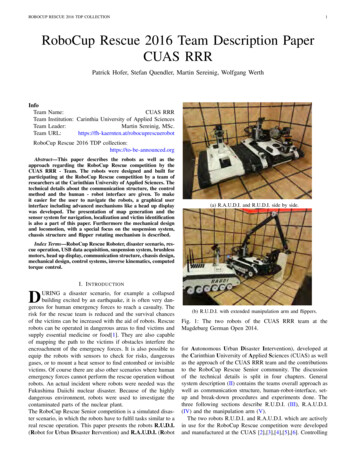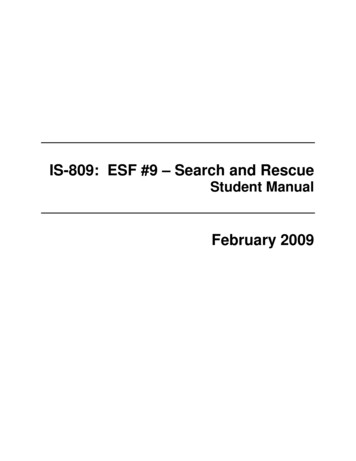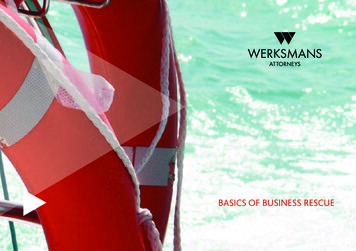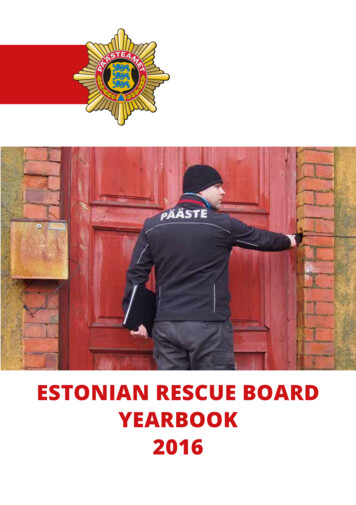
Transcription
ESTONIAN RESCUE BOARDYEARBOOK2016
ESTONIAN RESCUE BOARDYEARBOOK2016
ESTONIAN RESCUE BOARD YEARBOOK 20162TABLE OF CONTENTS2TABLE OF CONTENTS5INTRODUCTION7REALIZATION OF THE RESCUEBOARD’S OBJECTIVES14ACTIONS TO ACHIEVE OBJECTIVES14Accident prevention and civil protection23Cooperation and partnership30Modernisation of the technology36Fact-based planning and data analysis41Organisational capabilities50RESCUE CENTRES
ESTONIAN RESCUE BOARD YEARBOOK 20163FOREWORDDear reader!The Estonian Rescue Board is Estonia’s third largest, and the most respected governmental institution. According to a survey conducted by Turu-uuringute AS, we have the support of 95% of the Estonian population and,therefore, an increased burden of responsibility. We can say that we havewarranted this trust, as our consistent efforts have decreased the numberof fires and the fatalities caused by them. In 2016, for the first time, thenumber of fatalities caused by fires was under 40. Ten years of preventativework has seen the rate of fire fatalities decrease almost fourfold and deathsby drowning decrease nearly twofold. We know that the road ahead is adifficult one, as prevention alone is not enough to solve the reasons forwhy people perish in fire or water. Moving forward towards our strategicgoals, we depend on our ability to cooperate with different partners. Administrative reforms will create larger and more capable local governments,which we regard as our most important partners in ensuring the safetyof our citizens. We are looking to cooperate with new local governmentsto clarify areas of responsibility in supervising planning and construction,creating safety plans for welfare services, and improving local governments'preparedness for emergencies and coverage of vital services. We can raisepeople's risk awareness and their ability to act in an emergency situation byworking together with local governments and communities.Public trust in us is mainly based on people's belief that when difficultsituations arise we are there to help. This is supported by last year's survey on the public's crisis awareness, which revealed that the majority of
ESTONIAN RESCUE BOARD YEARBOOK 2016Estonians (59%) have done nothing to prevent or alleviate thelosses from potential emergencies. People also believe that thebigger an emergency, the faster the government (meaning rescueworkers, emergency services, and police) will come to help.One of the keywords for 2016 was the Rescue Board's sustainability. The “smart cuts” project provided a good opportunityto review the performance of the Rescue Board's functions andto implement changes that allow us to achieve the objectivesof our strategy, thereby corresponding to society’s expectationsand capacities. The number of non-rescue workers at the Rescue Board was decreased by 116 between 2011-2015, whichmakes up 25% of the total number of non-rescue workers. Thenumber of rescue workers has remained the same in that timeperiod. The management lost one member in 2016, and todaywe have only two deputy director generals. The reorganisationof the Rescue Board's structure and functions involved all departments and structural units of the Rescue Board. The staffcutbacks were made possible by reorganising the functions of theRescue Board's various departments, decreasing structural units,command units, and managers, and reorganising positions anddownsizing.“Estonian Rescue Board Yearbook 2016” is an informative booklet on last year's key activities and the realization of objectives. Ihope that every reader will find inspiration here for setting newobjectives and realizing them.I wish us all good luck!Kuno TammearuDirector General of the Rescue Board
ESTONIAN RESCUE BOARD YEARBOOK 20165INTRODUCTIONThe Rescue Board is a governmental institution within the Ministry ofInternal Affairs. Its mission is to prevent accidents and to save lives, property and the environment. The Rescue Board is the third largest Estonianpublic sector institution, employing approx. 2,200 people.Safetytraining2,271Rescue dispatches25 909Fire safetyconsultationsin homes17,071Proceedingsin fires1,956EOD incidents1,519Fire safety checks inbuildings4,625Self inspections3,408Construction siteinspections14,238About two thirds of the Rescue Board'sday-to-day activities focus on preventive measures. Last year, 62,931people (4.6% of Estonia’s total population) took part in safety training,and there were 17,071 fire safety consultations, covering 2.7% of all Estonian households. 4,625 buildings had fire safety checks, 898 of thoseduring special raids. Self inspections, where a company’s representativesassess the fire safety of their own establishments, were carried out 3,408times. The Rescue Board was dispatched 25,909 times in 2016 on suspicions of danger, of which 16,081 situations were actually dangerous.Rescue Board activities, 2016.
ESTONIAN RESCUE BOARD YEARBOOK 201662016 saw changes in our organisational structure, as we decreased command units and changed the division of tasksbetween departments to be more customer-oriented and effective. Our structural units are now: the safety supervisiondepartment (formerly the fire safety supervision department),the prevention department, the rescue work department, theemergency preparedness department (formerly the crisis management department) and the Explosive Ordnance DisposalCentre. The basis of these changes was the merging of chemicalsafety supervision with the fire safety supervision department,and the clarification of the Rescue Board's role in preparingcitizens, institutions, and members of the Rescue Board itselffor potential emergency situations.THE MISSION OF THE RESCUE BOARD:We prevent accidents,save lives, property, and the environment.ABIVALMIDUS THEVALUESjaOFabistameTHE RESCUEBOARD:märkameabivajajat.JULGUS julgeme otsustada, tegutseda ja vastutada.HELPFULNESSCOURAGEUSALDUS TRUSTusaldame ja meid usaldatakse.THE VISION OF THE RESCUE BOARD:By 2025, we will have reducedthe number of accidents and losses in Estoniato the level seen in Nordic countries.
ESTONIAN RESCUE BOARD YEARBOOK 20167REALIZATION OF THE RESCUEBOARD’S OBJECTIVESThe effectiveness of the Rescue Board is measured mainly through thechange in the number of accidents and the sustained damages resultingfrom them. The vision of the Rescue Board is to reach the level (thenumber of accidents and the extent of the consequences) of the Nordiccountries (Finland, Sweden, Norway, Denmark, and Iceland) in rescuerelated safety by 2025.4926Fires4031AFA false alarms3494Offering assistance22312081Fire false alarmsNatural disaster incidents1988Traffic accidents1470Helpless person1347Helpless animal/bird1289Explosive Ordnance Disposal incidents948Building fire threats430403Oil contaminationGas emergencies382Power grid emergencies214210Rescue team's clarification at the emergency scenesWater accidentsHousehold emergencies193Other113Chemical contamination76Training72Railway emergencies7Radioactive contamination31Plane accidents
8Number of incident calls. Rescue workers attended 25,909 incidentsin 2016. Fires constituted the largest number of rescue incidents, 19%of all calls and 30% of rescue incidents. The number of natural disaster incidents has tripled in two years – in 2014 there were 696incidents of storm damage, in 2015 the number of incidents increasedto 1780, and last year it was 2081. This is a continuing trend and theRescue Board, together with citizens, local governments, and businesses, must be prepared to prevent and alleviate potential losses, andeducate citizens in this matter. 9,828 calls were for false alarms, training, or providing services to other 0082009Residential building fires201020112012Fire-related fatalities20132014201520160Number of fires resultingin fatalitiesFire-related fatalities, fires resulting in fatalities, and residentialbuilding fires. In 2016, 39 people perished in 34 fires. That number is lower than ever before, but remains too high. Fires occurringin both apartment buildings and private residences resulted in fatalities; fires started from the living room or the kitchen were caused by
ESTONIAN RESCUE BOARD YEARBOOK 20169negligence or faulty appliances, and caused the deaths of both youngand old people. Although the number of residential building fires per1,000 people puts Estonia on the same level as Nordic countries, thenumber of fire-related fatalities remains three times higher than inits Nordic counterparts. A large number of fires resulting in fatalitiesare discovered too late, preventing rescue workers from saving humanlives after arriving at the den2016Number of fire-related fatalities per 100,000 citizens in the Nordics. In 2016, for the first time, the number of fire-related fatalitiesper 100,000 citizens in Estonia fell below 3. Ten years ago, havingstarted with preventative work, 12,6 people per 100,000 died in fires.Back then we had the highest number of fire-related fatalities per capita, alongside Russia and Latvia. Today we compare to the Nordics.The Rescue Board aims to reach the average level (approx. 1 fatalityper 100,000 citizens) of the Nordic countries by 2025, the total number being no more than 12 fatalities (39 in 2016).
10Unknown 76, 5%Faulty appliances 295, 21%Negligence821, 59%Natural hazards 15, 1%Unlawful behaviour 193, 14%Causes of building fires. A majority of building fires are caused bynegligence: placing candles near curtains, dropping a lit cigarette,putting hot ashes in a plastic bucket, thawing frozen pipes, leavingfood unattended on the stove, etc. The other major cause being faultyheating or other appliances. Burning of vegetation, ignoring bonfirerestrictions, arson, hooliganism, overheating of the sauna, etc., is considered unlawful behaviour.250204Drowning deaths975554566839 46201664201581 00616410219942752502252001751501251007550250
ESTONIAN RESCUE BOARD YEARBOOK 201611Water accident victims and survivors. In 2016, 3.5 people per100,000 citizens drowned in Estonia. Every fifth drowning victimwas a fisherman (total of 9 people), 8 people drowned when passingbodies of water (by slipping, stumbling, accidental falls), 7 peopledrowned while swimming, 4 people drowned in bathtubs, 3 peopledrowned while working near bodies of water, 2 people drowned inwatercraft activities, and in other cases the circumstances are unclearor unknown. 52 people were saved from water accidents.Call 65Fatalities2010012Injured13719668Bomb threats29312627123532School bombthreats1362131Bomb risk141171151128123138222Improvisedexplosive devices5633124Explosiveordnance disposal1088681717664104Explosive devices3102280830423552362746754084Total numberof calls1436130112831479161415201522The main indicators for the bomb disposal unit. In 2016, the numberof calls for bomb risk and explosive ordnance disposal rose. The currentinternational security situation can be considered as the main cause ofthis. Terror acts, explosions, and attacks against civilians in other partsof the world being covered by the media has also changed Estonians'sense of security. Fortunately, not one bomb risk call has turned out tobe a real explosive device or a blast caused by explosive substances.
000000383100000000500000000The Rescue Board's budgetPrevented losses in firesThe number of rescued people and the amount of prevented losses.The number of people rescued from fires, water accidents, traffic accidents, and other accidents was 383 last year. Comparing the amountinvested into preventative work over the last 10 years with the benefitsgained from decreasing the number of fatalities, the Rescue Board hasyielded approximately 1 billion euros for society. Every euro investedinto preventative work has saved 100 euros. The Rescue Board's workprevented the loss of an estimated 370 million in asset damages tosociety.
ESTONIAN RESCUE BOARD YEARBOOK 2016Subsidies andother transfers274,447, 0%13Finance lease3,124,600, 5%Investments1,554,275, 3%Labour costs37,610,448, 63%Administrativeexpenses17,009,373, 29%Expenses and investments of the Estonian Rescue Board in 2016.It is strategically important to the Rescue Board that the share ofinvestments maintains the sustainability of its activities. It is alsoimportant that the Rescue Board's wages remain competitive. In2016, the average wages of the Rescue Board remained at 1077 euros, 78.5% of the the average wages of the public administration anddefence sector. The Rescue Board's budget for 2016 was over 59.5million euros.
ESTONIAN RESCUE BOARD YEARBOOK 201614ACTIONS TO ACHIEVEOBJECTIVESThe Rescue Board's strategy until 2025 outlines five key strategic measures that will help realise our vision and achieve our objectives. The following is a rundown of relevant activities withinour strategic courses of action in 2016.Accident prevention and civil protectionPreparedness for emergencies. The focus was on how preparedpeople were for emergency situations. A survey was conductedlast year on people's knowledge of and preparedness for emergencies. The survey results and other topics related to awarenesswere touched upon at the strategy conference. The question ofhow each one of us has prepared for emergencies – as individuals, communities, and as a country, was posted. The resulting survey “The Population's Crisis Awareness” is found on ourwebsite.
ESTONIAN RESCUE BOARD YEARBOOK 2016The head of the emergency preparedness department, Tarmo Terep:“In 2016, two important changes came to pass at the RescueBoard in regard to crisis management. First of all, the structureof the institution became preventative, supervisory, and preparatory (reactive). These are the tools we can use to influenceand achieve the goals set in our strategy. Secondly, planningfor emergency preparedness and securing the continuity of theinstitution has affected every department. We found that everystructural unit can do something so that the Rescue Board cancontinue to help people in emergency situations.”15
Photo. Madis Sinivee, Pärnu Postimees.16Fire safe homes. Rescue workers, rescue service officials and volunteers offeredconsultations for 17,071 homes in the last year. This set the record for in-homeconsultations, as in 2015 the number was 16,354, in 2014 it was 8,725, and in2013 it was 1,655 homes. When in-home consultations first started in 2007,4,000 homes were visited. During the in-home consultation, the fire safety situation of the household is reviewed together with the resident, further adviceis given, and further ways to make the home safer are found together.The head of the prevention department, Indrek Ints:“Alongside fire and water safety matters, the risk of explosionsand the populace’s emergency preparedness emerged as issuesin 2016. The services shifted from being methodical to beingtopical. A broader approach to home safety was an importantaddition that will certainly be more established in the future.”
ESTONIAN RESCUE BOARD YEARBOOK 201617Water safety training for first graders. Water safety training for children in the first grade was launched in 2016. As children learn how toswim in elementary school, it is important to make them aware of thedangers of being in and around water. 9,739 first graders in Estoniawere trained in water safety in 2016.
18“Let's Do It!” collective action on water safety. The Rescue Boardtook part in the “Let's Do It!” day for the third time. The main themein 2016 was water safety. During water safety activities, 480 water safetyinformation stands were set up near public swimming areas with thehelp of Estonian people. Altogether, 9,000 people took part in thesecollective activities. Lifebuoys with a connecting line and informationboards with safety instructions were mounted on every stand.Besides water safety supplies, the 1,850 teamleaders received a smokedetector in their starterpack. The detector's special design won secondplace at the Estonian Design Awards.
ESTONIAN RESCUE BOARD YEARBOOK 2016“Love life, wear a life jacket!” was the message of the water safetycampaign aimed at users of watercraft.“Check it once a month”was the message of the firesafety campaign calling people to regularly maintaintheir smoke detectors.The Institute of the EstonianLanguage highlighted theRescue Board's campaignsin their competition for theClear Message Prize in thecategory of the Best Promoter, in which organisations areacknowledged for their outstanding and effective workin promoting clear socialcommunication.19
20A social media triumph. The Rescue Board's Facebook page gained3,450 followers in the last year, and currently has 42,851 followers.New narrated videos were produced with rescue workers and posted.Additionally, humorous but educational 1-minute lectures were produced, then viewed a total of 472,268 times. Thanks to the latter, theRescue Board was named the best social media campaigner in December 2016 by the CLE (Cannes Lions Estonia) Social Media Challenge.The Rescue Board is active and engaged on Twitter, keeping our over1,000 followers up to date on different rescue events. Even PrimeMinister Jüri Ratas keeps an eye on our tweets.
ESTONIAN RESCUE BOARD YEARBOOK 201621The Rescue Board at the Opinion Festival. For the first time ever,the Rescue Board presented their topics at the Opinion Festival. Together, ways to make a home a fortress and not a death trap wereexplored. For instance, member of parliament Heidy Purga debatedhome safety issues. The journalist Kärt Anvelt, survival instructor ErkiVaikre, and politician Silver Meikar were among others who sharedtheir ideas when discussing emergency preparedness.
22Additions to the library of the Estonian Firefighting Museum.The Estonian Firefighting Museum published a hefty book entitledFire Stations and Firehouses of Estonia. The book introduces Estonianfirehouse architecture, from woodshed-type structures to contemporary fire stations, in three languages (Estonian, Russian, and English).In addition, two old fire department flags (nominated for an EstonianAnnual Museum Award) and three old fire trucks were restored lastyear. The Museum was visited by 2,622 people.
ESTONIAN RESCUE BOARD YEARBOOK 201623Cooperation and partnershipFrequently, the causes of accidents are outside of the Rescue Board's areaof expertise. Therefore, effective cooperation with partners like privatebusinesses, other governmental institutions, and even volunteers, is ofutmost importance for the Rescue Board.Investing in safety. Thepan-EuropeanEurofound survey in 2016found that Estonianhouseholds are in a badcondition and oftendangerous. Contributions to home safetyare an investment for asafer tomorrow. Compared to other European countries, Estonia ischaracterised by a largenumber of homeowners. However, a lot ofpeople in Estonia havevery low incomes. Investments into fixinghome heating and electrical systems are madewith the support of local governments, local businesses, NGOs, andother projects. The Ministry of the Interior, MTÜ Eesti Pottsepad,and local governments together fixed 46 fireplaces in Estonia.
24Volunteer Academy. A training programme created for office workersin internal security who will become volunteer rescuers upon completing the course. The aim of the Academy is to educate employees insafety and to expand the army of rescue volunteers. After completingthe Volunteer Academy, those who wish can take part in the rescueservice unit's joint on-call duty and conduct preventative work.
ESTONIAN RESCUE BOARD YEARBOOK 2016Improving partnerships with the private sector. At the RescueBoard's instigation, special fire safety roles were created for the privatesector (fire safety specialist and fire safety expert). The Rescue Board'sgoal is to increase the number of individuals that can draw attentionto deficiencies in fire safety and help eliminate them. For example,chimney sweeps will check homes for smoke detectors and report theabsence of detectors to the Rescue Board.25
26Partnerships with research institutions. In the spring of 2016, students at the Design and Engineering programme, a joint internationalcurriculum of the Tallinn University of Technology and the EstonianAcademy of Arts, collaborated with the Rescue Board on a projectthat resulted in four innovative product ideas which will help the Rescue Board and ordinary people make life safer and more secure. Theseproduct ideas were: an intelligent range hood that extinguishes smallkitchen fires and burnt food, a safe and 'Instagrammable' space forbonfires and relaxation complete with a complementary app, a smartand complete system aimed at improving information exchange andmanagement at a rescue scene, and an autonomous hand washing device that reuses detergent and washing water. The project ended witha presentation of prototypes.
ESTONIAN RESCUE BOARD YEARBOOK 201627Saare Modex. SaareMODEX belongs to the EU MODEX international series of civil protection exercises and was held in Saaremaa.It was a challenge for both members of the Rescue Board's externalpartners, and local islanders. Bulgarians and Romanians took part inthe exercises alongside Estonians. The aim of the training was to practice operational cooperation in the case of large scale flooding. All ofthe water surrounding the Kuressaare Castle was pumped out usingdifferent techniques and methods.
28SAR cooperation with the JRCC Tallinn and the Police and Border Guard Board. Legislation was passed last year that regulates theRescue Board's role in reacting to maritime rescue situations with thenearest rescue provider. Until now, the same equipment was used torespond to both accidents on sea and inland bodies of water, limitingthe capacity of rescuers. The training and investments that began in2015 came to fruition in 2016 by increasing maritime response preparedness.
ESTONIAN RESCUE BOARD YEARBOOK 201629The Rescue Board's EOD Unit's partnerships. Close cooperationwith the Estonian Defence Forces' EOD team and the Estonian Navy's Divers Squad continues. The Rescue Board's EOD Unit also hasa strong and long-term partnership with the Swedish MSB's (CivilContingencies Agency) EOD team.During five days of planned EOD operations in Männiku and Valingu(which also involved the Estonian Defence Forces), 1,639 explosive deviceswere discovered and destroyed. Special equipment belonging to both theRescue Board and the Defence Forces was used during the operations.The head of the EOD Unit, Meelis Mesi:“2016 was the year for reviewing and setting the EOD Unit'sdevelopment trends. The EOD Unit has to act in accordancewith the international safety situation and participate more actively in lessening the risk of explosions. One of our prioritiesis devising a system for training our bomb squad, and we mustengage our partners wisely.”
30Modernisation of the technologyTo further improve the sustainability of public safety, technological advances must be skilfully utilised. However, technology makes us and ourorganisation more vulnerable, as we are increasingly relying on differentsystems that are out of our control.Drone usage. The Rescue Board purchased four drones meant forcivilian use as part of a pilot project. The Rescue Board intends to usethe purchased drones to assist with carrying out rescue work and EODoperations. The drones are currently capable of taking photos and videos from the air, helping to scope out large fires by providing constantsurveillance, thus increasing the efficiency of their use. The drones areused during EOD operations to help save time when inspecting danger zones and to provide a safer environment for the EOD squad. Thevital information needed to avert the danger of explosions or chemical, biological, radiological and nuclear defence (CBRN) hazards isobtained by not risking the lives of the squad.
ESTONIAN RESCUE BOARD YEARBOOK 201631More effective sea rescue. For the first time, the Rescue Board purchasedsix Yamaha VX Deluxe water scooters to make sea rescue more efficient.The water scooters were fitted with the necessary equipment for rescuework and were transformed into rescue water scooters. The new watercraftare located in Jõhvi, Kunda, Muuga, Keila, Tõstamaa, and Kihelkonna.By using water scooters, the Rescue Board is improving its capacity inreacting to water rescue incidents near the coast. The rescue water scooter instructors were professionally trained in the Netherlands. New waterrescue instructions were also created, which include surface rescue and theuse of the Rescue Board's watercraft near the coast.The head of the rescue work department, Heiki Soodla:“2016 was a good year for growth, and we focussed on creatingpreconditions for faster life-saving operations. An index was developed and implemented for the Rescue Board's on-call rescueworkers to measure fitness levels, and together with the Estonian Academy of Security Sciences, we implemented a programto advance and assess team leaders and rescue officers. Rescuecapacity was raised in the water rescue and situational awarenessareas, and water scooters and rescue drones were put into use.”
32Development of information systems. New info systems were builtin 2016 to make data processing easier and more effective. Appointments with a construction inspector can be booked in the RescueBoard's online booking environment.The first stage of the development of the EOD info system, DEMIS,which began in 2015 with the help of the Internal Security Fund(ISF), was completed. The system's platform, work flows, and statistical reports were updated during the first step. DEMIS developmentwill continue with the second stage in 2017.
ESTONIAN RESCUE BOARD YEARBOOK 201633In the prevention department, a preventative measures database wasdeveloped and implemented. The database gathers information onconsultations, training, and outreach activities conducted throughoutEstonia on an ongoing basis, making it easier to plan preventativeactions and to reach target audiences.The new DELTA document management system replaced the old andoutdated Postipoiss software.The TIIU asset management info system aims to manage fixed,low-value, rental property, and free use assets of the Ministry of Interior and the organisations within it, and to carry out various operations, from taking inventory of and managing assets, to writing offand expropriating assets.
34New EOD Unit equipment. The Internal Security Fund (ISF) andthe Ministry of the Interior financed the purchase of eight heavybomb suits, while the ISF also funded five small bomb robots. Bombsquads acquired three new EOD vehicles, while the CBRN team alsoreceived one.
ESTONIAN RESCUE BOARD YEARBOOK 201635Technology and prevention. A new sub-section titled “Safety technology” was started in partnership with the website geenius.ee, coveringtopics relating to the rescue field's technologies and innovations, bothin Estonia and abroad. The articles written on topics suggested by theRescue Board are written up by the journalists at geenius.ee. The mostread articles of the last year were stories on the new devices that warn acar if a rescue vehicle is approaching, self-appointed electrical experts,and dangerous phone chargers. The articles were read 2,942, 1,615, and1,263 times respectively.
36Fact-based planning and data analysisSystematic monitoring of the external and internal environment, and takinginto account any changes, is vital for all the Rescue Board's services. It isbecoming increasingly important to work effectively with a growing volumeof information and to ensure data quality. The development of the RescueBoard's data warehouse and analytical environment began in 2016, in orderto answer complex analytical questions quickly and prudently.Analysis of sustainability. A survey conducted by Finantsakadeemialast year evaluated the Rescue Board's financing needs in regard to theorganisation's strategies, objectives, external influences, and internalneeds. Based on its analysis of cost estimates and anticipated financingcapacities, the Rescue Board’s funding deficit will worsen. By 2026,the deficit is estimated to reach 27% of its total estimated costs.Therefore, the expected level of financing is not sustainable for achieving the objectives set for the Rescue Board. That means a decreasedsense of safety for the Estonian people in those areas where services arereduced or terminated. The estimated financing gap for the forecastperiod is a total of 148.7 million euros.
ESTONIAN RESCUE BOARD YEARBOOK 201637Fire safetyrequiremtsOISQualifiedprivate sevtorspecialist(no enforementby the state)Fire safetyinspection ofthe siteThe site(customer)Fire safetysupervisionIn orderIn orderNotFire safetyin orderNotinspection ENot in order in ordersite inspectionProposal deadlinePrecept(a penaltywarning Sitedeadline)inspectionThe method of risk-based monitoring. It is in the Rescue Board'ssafety supervision's capacity to check the fire safety compliance ofabout 5,000 buildings per year. Inspecting buildings with the highestrisk is a high priority. We assess risk via a tool that helps identify whichof Estonia’s hundreds of thousands of buildings have the highest firerisk. The method is based on the probability/consequence matrix. Thesource material is the Rescue Board's statistics on fires and the Register of Building's statistical data. Every building is given a risk categorythat sets the frequency of inspections. This method helps inspectorsreach the right build
ESTONIAN RESCUE BOARD YEARBOOK 2016 5 INTRODUCTION The Rescue Board is a governmental institution within the Ministry of Internal Affairs. Its mission is to prevent accidents and to save lives, prop-erty and the environment. The Rescue Board is the third largest Estonian public sector institution, employing approx. 2,200 people. Rescue Board .
